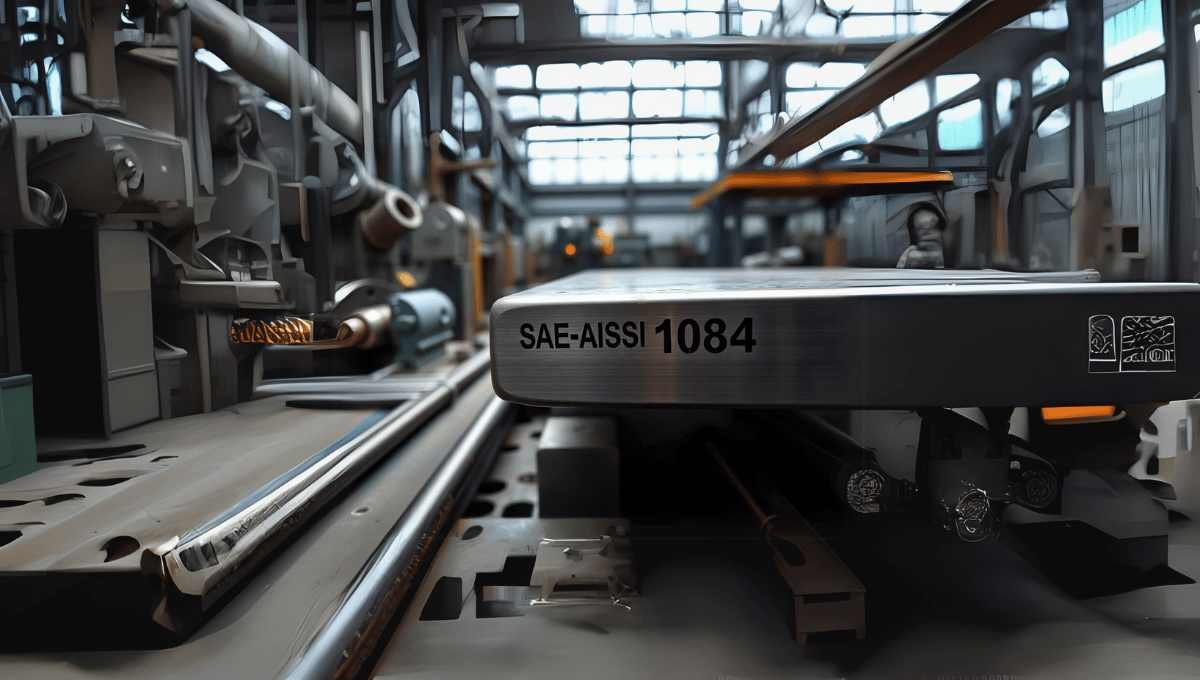Ultimate Tensile Strength of Steel 1084 is a trusted material for industries requiring strength, durability, and precision. It is known as high-carbon steel and delivers outstanding mechanical properties, making it ideal for manufacturing tools, blades, and heavy-duty components. One of its standout characteristics is its ultimate tensile strength the maximum stress the steel can handle before breaking. This strength makes 1084 steel highly sought after in applications that demand reliability under pressure. Whether you’re a manufacturer, engineer, or enthusiast, understanding the tensile properties, heat treatment options, and applications of 1084 steel is key to maximizing its potential in your projects.
AISI 1084 is a high-carbon steel widely known for its durability and performance in demanding applications. The alloy’s balance of hardness, tensile strength, and machinability makes it a go-to choice for toolmakers and manufacturers. One key feature of this steel is its ultimate tensile strength, a measure of the maximum stress it can withstand before breaking.
This article provides a clear, step-by-step overview of the factors influencing the tensile strength of steel 1084, heat treatment processes, and real-world applications.
Table of Contents
Chemical Composition of AISI 1084
Steel 1084’s mechanical and thermal properties are primarily influenced by its carefully balanced chemical composition. This composition determines the steel’s hardness, strength, and overall performance, making it suitable for a wide range of applications. By incorporating key alloying elements in precise proportions, 1084 achieves an ideal combination of cost-effectiveness and reliability.
Key Alloying Elements
- Carbon (0.80%-0.93%): Carbon is the primary contributor to the hardness and tensile strength of 1084 steel. It allows the alloy to maintain its structural integrity under stress, making it ideal for tools and machinery that require strength and durability.
- Manganese (0.60%-0.90%): Manganese improves the steel’s hardenability, ensuring uniform strength throughout the material. It also enhances wear resistance and helps refine the grain structure during heat treatment, contributing to the alloy’s overall toughness.
- Phosphorus and Sulfur: Present in trace amounts, phosphorus, and sulfur affect machinability and toughness. While phosphorus can slightly enhance strength, excessive amounts of these elements are avoided to maintain ductility and avoid brittleness.
The composition gives Ultimate Tensile Strength of Steel 1084 a strong balance of performance characteristics while maintaining cost-effectiveness.
Mechanical Properties of Steel 1084
The ultimate tensile strength of steel 1084 ranges from 700 to 1,200 MPa, showcasing its durability and versatility. These properties depend on precise manufacturing methods and heat treatments, making 1084 steel highly adaptable for varied applications.
Key Mechanical Metrics
- Tensile Strength: Tensile strength measures the steel’s ability to resist breaking under stress. Steel 1084’s high tensile strength ensures its durability in applications requiring significant load-bearing capacity.
- Elastic Modulus: This property reflects the material’s capacity to return to its original shape after deformation. Steel 1084’s elastic modulus contributes to its reliability under cyclical stress and vibration.
- Hardness: The hardness of 1084 steel typically ranges from 54 to 60 HRC, depending on the heat treatment applied. This ensures excellent resistance to wear, making the steel ideal for cutting tools and impact applications.
These properties make 1084 steel highly effective in applications requiring high-impact resistance.
Tensile Strength in Focus
Tensile strength is critical for materials in high-stress environments. For steel 1084, its ability to withstand stretching and pulling forces without failure makes it invaluable for demanding applications such as tools, springs, and structural components.
Comparison with Other Steels
Steel 1084 offers unique advantages over other high-carbon steels. Compared to 1095, it is easier to heat-treat and offers similar tensile strength. Compared to 5160, steel 1084 exhibits higher tensile strength, making it more suitable for tools requiring sharp edges or higher impact resistance.
Heat Treatment and Its Influence
Heat treatment is essential in unlocking the full potential of Ultimate Tensile Strength of Steel 1084. The microstructure of the steel is altered during heat treatment processes, allowing for improved hardness, strength, and machinability.
Key Processes
- Annealing: Annealing softens the steel by relieving internal stresses and refining its grain structure. This improves machinability and prepares the steel for further processing.
- Quenching: Quenching involves rapidly cooling the steel to increase its hardness and tensile strength. This process enhances the steel’s ability to withstand high stresses without deformation.
- Tempering: Tempering reduces brittleness in quenched steel while maintaining its strength. By carefully controlling the tempering temperature, manufacturers can achieve the desired balance of hardness and flexibility.
Proper heat treatment can increase the Ultimate Tensile Strength of Steel 1084 to its maximum potential.
Thermal Properties of 1084 Steel
Thermal properties determine how steel behaves under temperature variations, making them essential for processing and applications. Steel 1084’s thermal performance ensures it meets the demands of heat-intensive environments.
Key Thermal Characteristics
- Thermal Conductivity: This property allows for efficient heat distribution during processing, ensuring consistent microstructural changes throughout the material.
- Thermal Expansion: Thermal expansion describes how steel 1084 expands when heated. Understanding this property is critical for applications where the material undergoes frequent temperature changes.
These properties ensure reliable performance in both industrial and outdoor conditions.
Testing Tensile Strength
Testing the ultimate tensile strength of steel 1084 involves standardized methods that provide accurate and reliable results. These tests help manufacturers confirm the steel’s suitability for specific applications.
How to Calculate Tensile Strength
The maximum load the material can bear is divided by its cross-sectional area to measure tensile strength. Tools such as Matweb or Makeitfrom.com provide reference data, ensuring calculations reflect the steel’s actual performance. Variations in results often arise from differences in composition and processing.
Testing results can vary slightly due to differences in composition and processing techniques.
Applications of 1084 Carbon Steel
Steel 1084’s combination of tensile strength, durability, and affordability makes it a favourite for various applications in manufacturing and construction.
Popular Applications
- Blades and Cutting Tools: The steel’s ability to hold sharp edges and resist wear makes it a top choice for crafting high-performance knives and cutting tools.
- Springs: Steel 1084’s tensile strength and flexibility make it ideal for springs used in high-impact environments, such as automotive and industrial machinery.
Its balance of performance and affordability make it an excellent material for small- and large-scale projects.
Comparison with Other Steels
Ultimate Tensile Strength of Steel 1084 is frequently compared to similar high-carbon steels like 1095 and 5160 due to its performance balance.
Key Differences
- 1084 vs. 1095: Steel 1084 is easier to heat-treat, offering comparable strength with slightly lower hardness. This makes it more forgiving for complex manufacturing processes.
- 1084 vs. 5160: With higher tensile strength, steel 1084 is better suited for applications requiring sharp edges or high stress. 5160, on the other hand, offers more flexibility for specialized applications like automotive springs.
These comparisons highlight 1084 steel’s unique advantages, particularly for applications requiring a balance of hardness and flexibility.
Production and Standards
Steel 1084 is produced in compliance with stringent industry standards, ensuring its consistency and reliability.
Specifications
Steel 1084 is available in various forms, including sheets, bars, and rods, to accommodate diverse manufacturing needs. It conforms to ASTM specifications, ensuring quality and performance standards are met in all applications.
These factors ensure that Steel 1084 meets diverse application needs.
Conclusion
Steel 1084 is a high-performance alloy valued for its Ultimate Tensile Strength of Steel 1084, durability, and adaptability. Its chemical composition, dominated by carbon and manganese, gives it an ideal balance of hardness and tensile properties. Heat treatment processes such as annealing, quenching, and tempering allow manufacturers to customize their performance for specific applications.
With tensile strength ranging between 700 and 1,200 MPa, Ultimate Tensile Strength of Steel 1084 proves its worth in tools, springs, and cutting equipment. Compared to other high-carbon steels, it offers easier heat treatment and comparable strength, making it a versatile and affordable choice.
Whether used in industrial or consumer applications, steel 1084’s performance stands out. Manufacturers and engineers can fully utilize its potential in diverse applications by understanding its mechanical, thermal, and tensile properties.
FAQ’s
What is the ultimate tensile strength of SAE-AISI 1084 steel?
The ultimate tensile strength of steel 1084 typically ranges from 700 to 1,200 MPa, depending on heat treatment and processing, making it suitable for high-stress applications.
How does the ultimate tensile strength of UNS G10840 compare to other wrought carbon or non-alloy steels?
The ultimate tensile strength of steel 1084 (UNS G10840) is comparable to 1095 steel but easier to heat-treat and exceeds 5160 steel in strength, making it more versatile.
What is the chemical composition of SAE-AISI 1084 steel?
SAE-AISI 1084 steel contains 0.80%-0.93% carbon, 0.60%-0.90% manganese, and trace amounts of phosphorus and sulfur, giving it excellent strength and machinability.
What are the mechanical properties of SAE-AISI 1084 steel?
The ultimate tensile strength of steel 1084, high hardness (54–60 HRC), and reliable elastic modulus ensure it performs well under high impact and stress.
How does SAE-AISI 1084 steel behave under thermal conditions?
Ultimate Tensile Strength of Steel 1084 exhibits stable thermal properties, including efficient thermal conductivity and manageable thermal expansion, ensuring consistent performance during heat treatment and applications.
How is SAE-AISI 1084 steel heat-treated and processed?
SAE-AISI 1084 undergoes annealing for stress relief, quenching for hardness, and tempering to reduce brittleness while maintaining its ultimate tensile strength.
What are some otherwise unclassified properties of SAE-AISI 1084 steel?
Ultimate Tensile Strength of Steel 1084 is known for its affordability, ease of processing, and versatility across various applications, aside from its ultimate tensile strength and thermal stability.
Can SAE-AISI 1084 steel withstand room temperature applications?
Yes, SAE-AISI 1084 steel performs exceptionally well in room-temperature applications due to its tensile strength and machinability balance.
What are the common uses of SAE-AISI 1084 steel?
Steel 1084 is widely used in manufacturing cutting tools, springs, and industrial equipment due to its ultimate tensile strength and durability.
How does SAE-AISI 1084 compare with other steel grades?
Steel 1084 offers easier heat treatment than 1095 and higher tensile strength than 5160, making it a more versatile choice for varied industrial uses.

